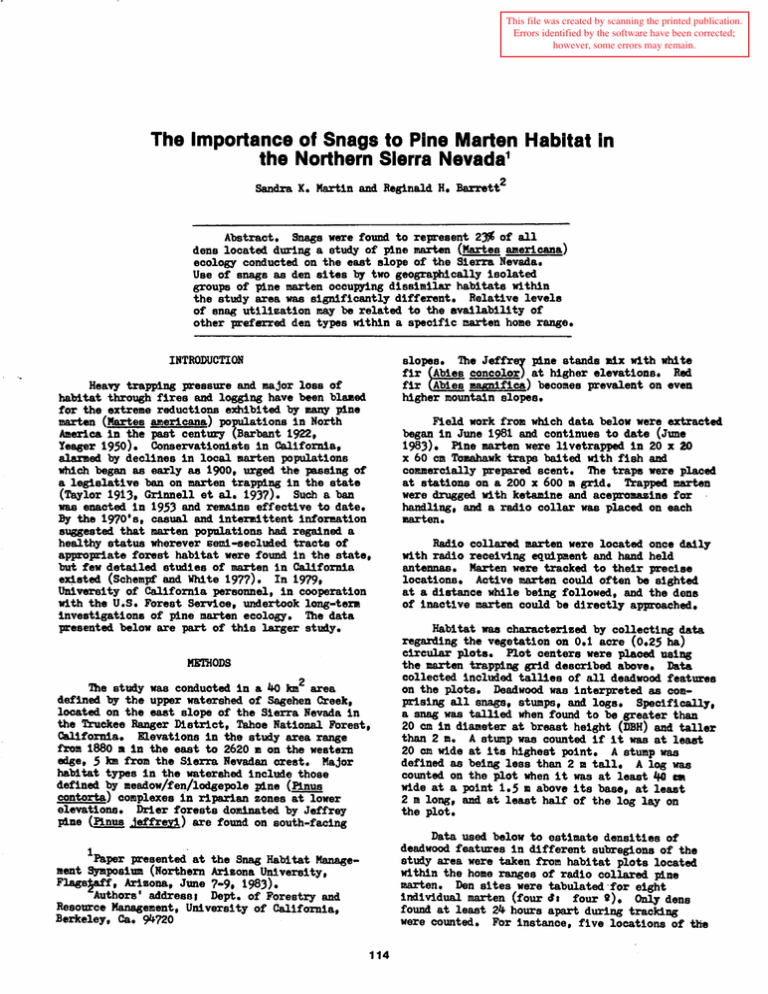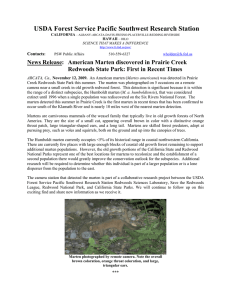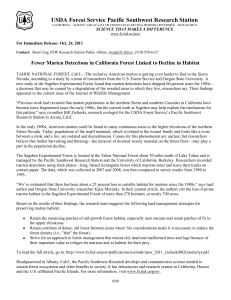The Importance of Snags to Pine ... the Northern Sierra Nevada x.
advertisement

This file was created by scanning the printed publication. Errors identified by the software have been corrected; however, some errors may remain. The Importance of Snags to Pine Marten Habitat In the Northern Sierra Nevada1 Sandra x. Martin and Reginald H. Barrett2 Abstract. Snags were found to represent 2~ of all dens located during a study of pine marten (Martes ueric&Da) ecology conducted on the east slope of the Sierra Nevada. Use of snags as den si tea by two geographically isolated groups of pine marten occupying dissimUar habitats 1d.thin the study area was significantly different. Relative levels of snag utilization may be related to the availability of other preferred den types within a specific marten home range. INTRODUCTION Heavy trapping pressure and major loss of habitat through fires and logging have been blued for the extreme reductions exhibited by many pine marten (Martes americana) pol'\Jlations in North America in the past century (Barbant 1922, Yeager 1950). Conservationists in California, alarmed by declines in local marten populations which. began as early aa 1900, urged the passing of a legislative ban on marten trapping in the state (~lor 1913, GriDDell et al. 1937). Such a ban was enacted in 1953 and remains effective to date. By the 1970's, casual and intermittent information suggested that marten populations had regained a healthy status wherever semi-secluded tracts of appropriate forest habitat were found in the state, but few detailed studies of marten in California existed (Schempf and White 1977). In 1979, University of California personnel, in cooperation with the u.s. Forest Service, undertook long-term investigations of pine marten ecology. '!he data presented below are part of this larger study. METHODS '!he study vas conducted in a 40 m2 area defined by the upper watershed of Sagehen Creek, located on the east slope of the Sierra Nevada in the Truckee Ranger District, Tahoe National Forest, Cal1.forn1a. Elevations in the study area range from 1880 a in the east to 2620 m on the western edge, S km from the Sierra Nevadan crest. Major habitat types in the watershed include those defined by meadow/fen/lodgepole pine (Pinus contort&) complexes in riparian zones at lower elevations. Drier forests dominated by Jeffrey plne (Pinus 1effrex1) are found on south-facing 1 slopes. '!he Jeffre'f pine stands mix 1f1th wh1 te fir ~Abies concolo~) at higher elevations. Red fir Abies magnifica) becomes prevalent on even higher mountain slopes. Field work from which data below were extracted began in June 1981 and continues to date (June 1983). Pine marten were li vetrapped in 20 x 20 x 60 em Toll8ha.vk traps ba1 ted 1d. th fish and commercially prepared scent. 'Dle traps were placed at stations on a 200 x 600 m grid. Trapped marten were drugged with ketamine and acepromazine for handling, and a radio collar was placed on each marten. Radio collared marten were located once daily with radio receiving equipment and hand held antennas. Marten were tracked to their precise locations. Active marten could often be sighted at a distance while being followed, and the dens of inactive marten could be directly approached. Habitat was characterized by collecting data regarding the vegetation on 0.1 acre (0.25 ha) circular plots. Plot centers were placed using the marten trapping grid described above. Data collected included tallies of all deadwood features on the plots. Deadwood was interpreted as comprising all snags, stumps, and logs. Specificall;r, a snag was tallied when found to be greater than 20 em in diameter at breast height (DBH) and taller than 2 m. A stump was counted if it vas at least 20 em wide at its highest point. A stump was defined as being less than 2 m tall. A log was counted on the plot when it vas at least 40 em 1d.de at a point 1.5 m above its base, at least 2 m long, and at least half of the log lay on the plot, Data used below to estimate densities of deadwood features in different subregions of the study area were taken from habitat plots located within the home ranges of radio collared pine marten. Den sites were tabulated·for eight 1ndividual marten (four & 1 four t). Only dens found at least 24 hours apart during tracking were counted. For instance, five locations of the . Paper presented at the Snag Habitat Management Symposium (Northern Arizona University, Flags~, Arimona, J~e 7-9, 1983). Authors • address J Dept. of Forestry and Resource Management, University of California, Berkeley, Ca. 94720 114 same marten in the same d~n in a single 24 hour (midnight to midnight) period would be tabulated as one den site location. Table 1. Den types used by pine mart~n in the upper and lower subregions of Sagehen Creek Watershed. Relationships between marten sex and den type, and between geographic location of marten dens and den type, were examined with the 2 x 2 test of independence using the G-statistic (Sokal and Rohlf 1969• 591-921. A.2Student's t test, modified to account for d': = a:, was used to compare average densities of ~abitlt components in two different subregions of the study area (Cochran 1964). Total number of den sites located Number of snag dens Percent of total N\UIIber of deadwood dens Percent of total RESULTS Pine marten investigated in this study typically occupied a den for periods ranging from one to seven days. They remained inactive within the den for several hours at a time, often leaving to hunt and returning later. Marten are usually solitary except during brief mating liasons in summer. Another social grouping forms when kits stay with their mother from birth in early spring until late summer. r.,embers of these social groups often occupy the same den simultaneously. Upper Basin Lower Basin 165 29 17.6 121 85 28 )2.9 49 7).) 57.6 the designated areas. Mean snag densities were 10.74/acre (26.54/ha) in the lower basin (below 2250 m elevation) and 8.78/acre (21.70/ha) in the upper basin (table 2). Using a modified t test, no significant difference between these two means was found (test statistic=0.699 1 t'=1.674). Deadwood dens (snags, stumps, and logs) pooled together represented 6~ of all marten den sites. As with snag dens alone, the hypothesis of independence between geograyhic location (upper and lower basin) and den type ~deadwood and other dens) was rejected (G=6.224, X: =3.841 ). Marten (l::S0.05, d.f.=1 in the upper basin were found to be using proportionally more deadwood dens than those in the lower basin (table 1). · A common movement pattern identified was for a pine marten to occupy a den for one or two days, then shift to another den w1 thin a few hundred meters of the first. Another shift would occur a day or tKo later. Dens within one specific area of the home range were often used for a few weeks, with the marten then completely shifting activity and den occupation to another area of its home range. Specific den sites were often used again after the initial occupation. Home ranges of the pine marten overlapped to varying degrees, and some sites were used by two or even three individuals at different times. Densities of stumps and logs in the two geographic areas were obtained in the same manner that snag densities were calculated. Modified t tests indicated that stump density in the upper basin was significantly higher than that in the lower basin (test statistic=2.)2, t'::s1.680)(table 2). A similar result was found when log densities in· the upper and lower basin areas were compared (test statistic=).o., t'=1.671)(table 2). Types of den sites included the following categories; snags, stumps, logs, the canopy of trees, willow (~ spp.) clumps, other brush, rock slides, and subni vea.."l dens of unknown structure. Snags represented 23% of all den si. tea found (n=250). When only those dens used more than once were considered, snags were found to incorporate 27% of the total (n=90) • DISCUSSION Dens were divided into the categories •snags" and "other dens". Den type was then found to be independent of the sex of the occupying marten 2 (G=0.)01, 'X: Cl=0.05 , d.f .at =).841 ). Marten den locations were also divided into two geographic categoriesa those of marten located in the western half of the study area, above 2250 m elevation (upper basin marten), and those found in the eastern end of the watershed (lower basin marten). The independence of snag and non-snag dens was tested with these two geographic categories. The null hypoth~sis of independence was rejected (G=7.268, X Cl:Oe05 , d.f 1=).841 ). Specifically, marten in the lower basin area used proportionally more sn~s as dens than did upper basin marten (table 1). Snags are an important habitat component for pine marten ln the Sagehen Creek watershed. One quarter of all den sites located for eight radio collared marten were in snags. 'lbe sex of marten appears irrelevant to discussions of den type selection. Geographic location, i.e. separating marten found in the upper or lower elevations of the study area, had a significant effect' on analysis of den type selection. This geographic separation· is justifiable on two counts J the categories represent two completely divided groups of marten occup,ying dissimilar habitat. Home ranges of the four marten found in the lower basin overlap extensively, but none of these overlap with home ranges of any upper basin marten. A similar situation exists among the four upper basin marten. ~arten in the lower basin occupy lodgepole pine/ white fir forests. Those in the upper basin are found in red fir/white fir forests. Snag densities for each of these two geographic areas were taken from habitat plots within Marten in the lower basin used snags proportionally more than did upper basin marten. However, .= 115 Table 2. Average densities of deadwood features in the upper and lower subregions of Sagehen Creek Watershed. Snags per acre s2 i n Upper Basin 41 Lower Basin 2? 8.?8 1?0.98 10.?4 99.43 Snags per hectare Stumps per acre s2 i n Stumps per hectare Logs per acre -2 n i 8 Logs per hectare 21.?0 41 16.10 169.39 39.?8 41 1).1? 19?.20 32.62 26.54 2? 8.89 148.?2 21.9? 2? 4.44 94.8? 10.8? snag densities appear to be similar in these two areas. Marten in the upper basin used more deadwood dens overall than did marten in the lower basin. These facts appear somewhat contradictory, but when stump and log densities in the two subregions are compared, a probable explanation emerges. The upper basin habitat provides a greater number of stumps and logs as possible den sites for marten than can be found in the lower basin, Marten are opportunistic, to a degree, in den selection. Deadwood sites provide preferred den locations, but where densities of snags, stumps, and logs are not high, other habitat features are utilized. Snags probably gain importance as marten den sites in areas where logging has not recently occurred, or where stump and log densities are naturally low. A history of timber harvest activities in the Sagehen Creek basin reveals that extensive logging occurred at lower elevations between 1900-1920, and that a timber sale in 196? resulted in str11>-cut harvests in the upper basin (West 1982). The logging operation of 16 years ago is the most likely reason for the current high log and stump densities found in the upper basin. Further analyses of den characteristics are being undertaken, and may disclose the importance of features beyond simple availability in marten den selection. Characteristics of suspected significance include size (DBH, height, and length), state of deterioration, proximity and amount of overhead canopy cover, and clustering of acceptable dens. Snags should be respected as potential den sites in all areas where the marten occurs. However, snags are particularly important where logging has not been common. The natural decay of snags would 116 also be a primary factor in providing stUlllps and logs for marten dens in such undisturbed habitat. LITERATURE CITED Brabant, A. 1922. The fire fiend's threat to the fur trade. Illustrated Can. For. l'.ag. 18(12)• 12o4-120S. Cochran, W. G. 1964. Approxitna.te significance levels of the Behrens-Fisher teat. Biometrics 201 191-195. Grinnell, J •• J. ·s. Dixon, and J. M. Linsdale. 193?. Fur-bearing mammals of California. 3?5 P• Univ. of Calif. Press, Berkeley, Calif. Schempf, P. F. and fe!. White. 19??. Status of six furbearer populations in the mountains of northern California. 51 p. USDA Forest Service, San Francisco, Calif. (unnumbered publication) Sokal, R. R. and F. J. Rohlf. 1969. Biometry. 776 p. w. H. Freeman and Co., San Francisco, Calif. Taylor, W. P. 1913. Fur-bearing mammalsJ an. unappreciated natural resource. Science 3?• 485-487. West, c. I. 1982. Management options for the Sagehen Creek basin. 110 P• M. s. F~ Prof. Pap., Univ. of Calif., Berkeley. Yeager, L. E. 1950. Implications of some harvest and habitat factors on pine marten management. Trans. N. Am. Wildl. Conf. 1St :319- 334.





